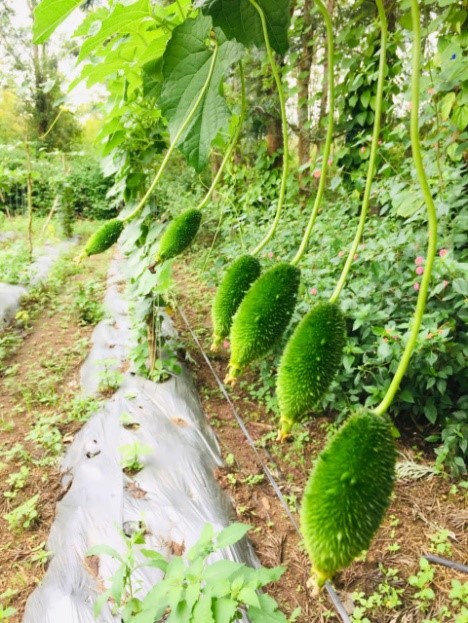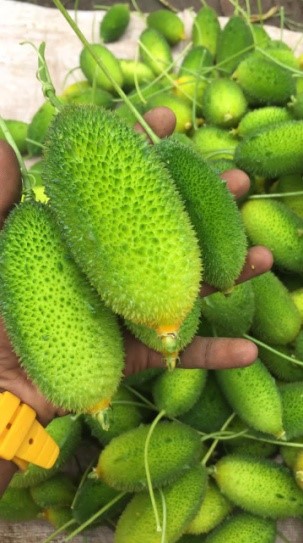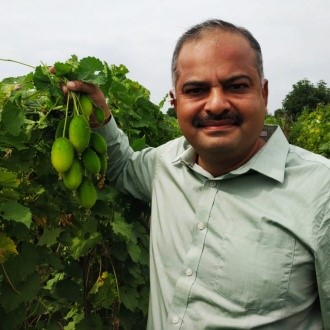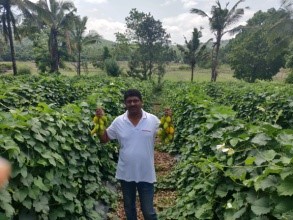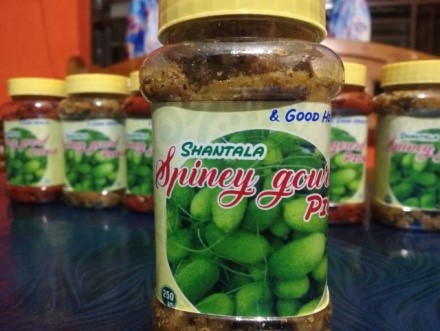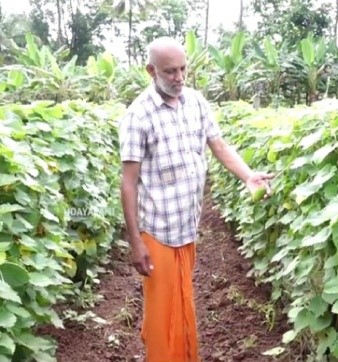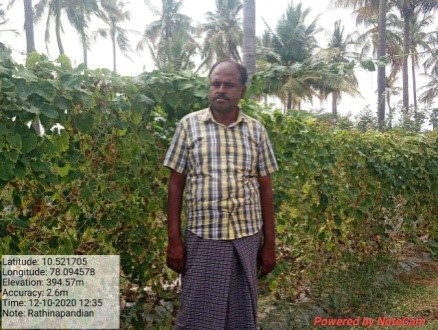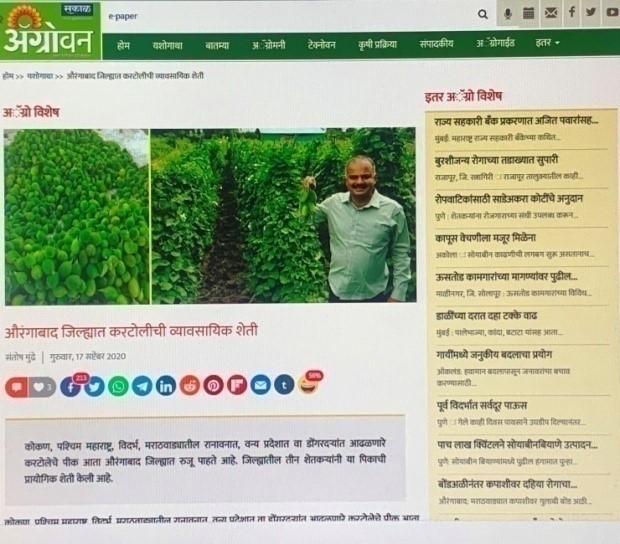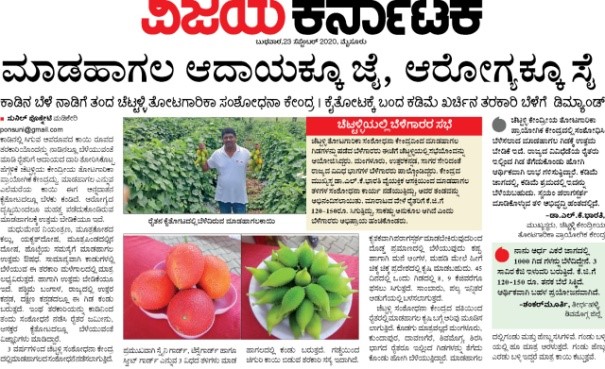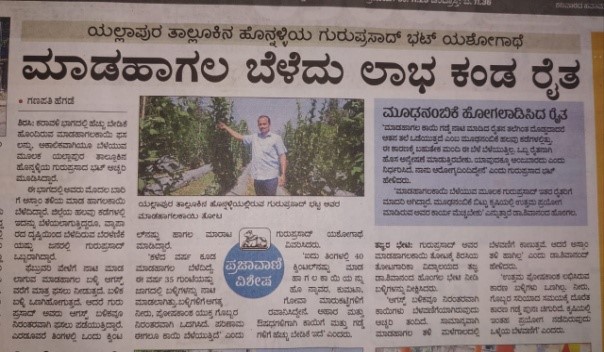There is a call by our Honorable Prime Minister to double the farmers’ income by 2022. To achieve this there is a need that either farmers increase their productivity or reduce the cost of cultivation or start growing new crops or varieties which can fetch high market price. One such potential crop which fits into the third category is teasel gourd (Momordica subangulata Blume subsp. renigera (G. Don) de Wilde), a vegetable crop which hitherto used to come only from wild as no released variety was available for domestic cultivation.
Spine gourds (M. dioca Roxb. and M. sahyadrica Kattuk. & V. T. Antony) which are locally known as Madahagalakayi (Karnataka), Kartoli (Maharashtra), Aakakarakayi (Andhra Pradesh & Telengana), Pazhupavakkai (Tamil Nadu), and kattu pavakkai/Eruma paval (Kerala) is generally grown by just few farmers, mostly for their own consumption in homesteads and/or those which collected wildly are sold in the market. Since the vegetable is seasonal it appears in the market occasionally once in a while, fetches a price of as high as Rs. 200 per kg. Spine gourd plants sprout only after the onset of the monsoon and bears fruit from August-January. The fruits are very small (weigh only 20 – 30 g) and yield is very low (2 – 3 kg/plant). On the contrary, its Assamese counterpart known as teasel gourd, a semi domesticated crop, is easy to multiply and cultivate commercially. Currently it is widely cultivated in West Bengal, Odisha and north eastern states. It sprouts by January-February and can give fruits for almost 6 months (April-August). Even though there is high demand for spine gourd in Southern parts of India and Maharashtra, commercial cultivation of spine gourd is not picking up mainly due to lack of standard propagation technique for mass multiplication. Therefore, the fruits of teasel gourd (as an alternate to spine gourd) come from West Bengal to the markets of Karnataka. Under this backdrop, for the benefit of the farming community and also in the consumer perspective a research programme on teasel gourd was initiated at Central Horticultural Experiment Station (CHES), Chettalli, a regional station of ICAR – Indian Institute of Horticultural Research, Bengaluru during the year 2016-17 and a high yielding selection, namely Arka Bharath was identified for commercial cultivation.
Immediate impact of technology
For the first time, CHES (ICAR-IIHR), Chettalli introduced and popularized commercial cultivation of teasel gourd in Kodagu, Uttara Kannada and Dakshina Kannada districts of Karnataka. Around 45,000 plants of Arka Bharath were also supplied to more than 250 farmers of Tamil Nadu, Karnataka, Kerala, Andhra Pradesh, Telengana, Gujarath, Odisha and Maharashtra and the demand is increasing day by day.
During an interaction meet with teasel gourd growers held at ICAR-IIHR-CHES, Chettalli, Kodagu district of Karnataka the farmers expressed their gratitude to the research station for supplying teasel gourd (Var. Arka Bharath) plants and for providing technical guidance and support through which they were immensely benefitted. The detail of few successful growers of Arka Bharath from Karnataka, Maharashtra and Tamil Nadu is given below.
Mr. Milind Kulkarni (Mobile No. - 8999905139) a farmer from Deogaon, Rangari village of Aurangabad district, Maharashtra is reaping rich dividends and has become an inspiration to many by cultivating teasel gourd var. Arka Bharath. He had planted 300 plants at 1.5 × 1.5 m spacing in an area of 0.17 acres. He harvested around 1.5 t of fruits and sold directly to customers in Aurangabad city. Owing to the high demand for this vegetable, he got a premium average market price of Rs. 150-200 per kg and got income of Rs. 2, 10, 000 from 0.17 acre in a span of 6 months.
Mr. Shankar Murthy (Mobile No. - 6362013671) a B. Com. graduate from Kuppalli village, Shivamogga district, Karnataka has started commercial cultivation of teasel gourd for the first time in that region. He has planted 1000 teasel gourd plants variety Arka Bharath in a half acre land and harvested nearly 3000 kg. Each kilogram fetched him between Rs 150-200, much higher returns than other vegetable crops. He is very happy with this vegetable growing.
Mr. Guruprasad M. Bhat (Mobile No. - 9343138861), a teasel gourd grower from Yellapura, Uttara Kannada, Karnataka has grown 850 Arka Bharath teasel gourd plants. He harvested about 4000 kg fruits and sold @ Rs. 80-150 per kg. Apart from selling the fruits, he has done some value addition by making teasel gourd pickles and selling in Goa markets. He says there is also demand for such value added products in the market.
Mr. Venkatesh(Mobile No. 9141942021), from Kushal Nagara, Kodagu district having 300 teasel gourd (var. Arka Bharath) plants obtained 750 kg and still there is crop for further harvests. He also highlighted that there is a huge market demand for this vegetable in Kodagu district and he was very much benefitted by growing Arka Bharath. He sold the fruits @ Rs. 80-120/kg and realized a gross income of Rs. 80,000 from 0.25 acre land.
Similarly, Mr. Shivananda (Mobile No. - 9901980644), a farmer from Karkala, Mangalore expressed that he harvested 3500 kg by growing 600 plants and obtained more than 6 kg per plant and is expecting nearly 10 kg yield per plant. He has sold the fruits for Rs. 100-150/kg and realized a gross income of Rs 5, 00,000.
Mr. Rathna Pandian R., (Mobile No. - 9751974141) Paganathem village of Dindigul district, Tamil Nadu grew teasel gourd as an intercrop in the existing coconut garden maintained at 8 m × 8 m spacing. He planted 250 teasel gourd plants in between the coconut trees and used the coconut trees as pole for training the plants thereby reduced cost of erecting training system. With least investment (Rs. 15,000 to 20,000 towards cost of plants, GI wire and fish net) he got an additional income of Rs. 40,000 from 0.5 acre coconut garden. Now he is planning to expand the area under this crop in other coconut plantations.
Success stories of few teasel gourd (var. Arka Bharath) growers published in Newspapers and Magazines
